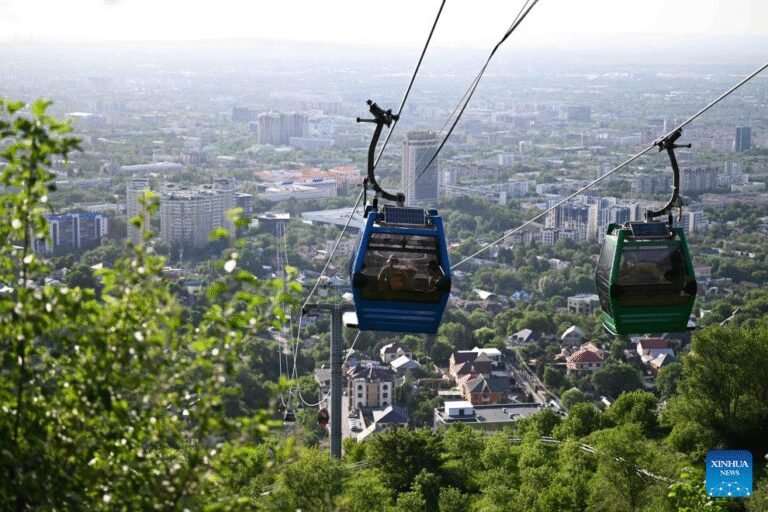
Tourists ride cable cars at the Kok Tobe Mountain in Almaty, Kazakhstan on May 13, 2025. (Xinhua/Li Renzi)
TACHENG, China, Sept. 22 (Xinhua) — Border port cities in northwest China’s Xinjiang have seen a boom in cross-border tourism propelled by a visa-free agreement between China and Kazakhstan since it took effect in November 2023.
INCREASING TRAVEL ROUTES
“This summer, I made two trips to the Alakol Lake in Kazakhstan,” said Tao Qin, a Tacheng city resident in Xinjiang Uygur Autonomous Region.
Lake swimming and mud bath are among the attractions in the increasingly popular tourism destination to Tacheng residents. The lake resort is just a bus trip of more than two hours from the Baktu land port located in the city, Tao said.
Many tourists like Tao and others from across China opt for a three-day tour program to the Kazakh lake offered by the local office of Shaanxi Gaoke International Travel Agency. Wang Long, the Tacheng branch manager, said that this past summer, they dispatched two tour groups every 10 days to the Alakol Lake. The China-Kazakhstan visa-free agreement has brought the lake — a distant view for Tacheng residents — into easy reach, according to Wang.
The designation of 2024 as the “Year of Kazakhstan Tourism in China” and 2025 as the “Year of China Tourism in Kazakhstan” has significantly boosted cross-border traveler traffic through Xinjiang’s border ports, including Alashankou. Popular Kazakhstan-bound itineraries — such as a one-day tour to Dostyk, a three-day tour to Alakol Lake, or a seven-day tour to Almaty — are receiving growing numbers of bookings. The Alashankou city is going to resume its international passenger transport lines to Ucharal and Taldykorghan in Kazakhstan.
Almaty received 54,100 Chinese tourists in the first half of 2025, up by 33.4 percent from a year earlier, according to data from the tourism department of the largest Kazakh city.
CLOSER COOPERATION
Kazakh travel agency Nur-Gany and Xinjiang Tacheng Travel Service Co., Ltd. have been in cooperation on jointly developing cross-border tour routes, including local reception services.
“The cooperation is progressing rapidly. We regularly receive tour groups from China and collaborate on new programs,” said Kalymzhanova Nazym, Nur-Gany’s general manager.
She said prospective programs include those on eco-tourism and cultural exchange, while the Tacheng company said it is planning a joint operation of Xinjiang-bound tours for Kazakhs.
In May, Kazakhstan’s low-cost carrier FlyArystan launched a direct flight service between Almaty and Xinjiang’s Yining city; in October, it will increase the flight frequency from two to three per week. The DKNews of Kazakhstan reported that this move supports the development of Kazakhstan-China relations and creates new options for travelers.
BETTER SERVICES
In response to growing tourist arrivals, Xinjiang’s border ports have been working to provide greater facilitation.
Take the Horgos Cross-border Tourism One-stop Service Center. The service center became operational in August and has drawn in dozens of businesses to set up services, such as travel agencies, customs declaration firms, translation agencies, insurance companies, and car rental businesses.
According to immigration officer Zhang Yongpeng, passenger traffic through the Horgos port this year exceeded 1 million in late August, a 60 percent jump from the previous year.
In the port’s entry inspection hall, streams of people were using AI-powered self-service terminal machines for swifter entry registration, a process taking just over 10 seconds at its fastest, thanks to automatic identification and capture of individual passport information and native language checks, according to Zhang. A special tour group consisting of motorcycle enthusiasts from countries including Poland, Canada and Greece was waiting to clear customs. Their journey started from Kyrgyzstan and passed through Kazakhstan, and will end in Nepal.
Grzegorz Brzeczyszczykiewicz, a motorcyclist from Poland, said that the motorcycle team would ride all the way to Urumqi, Xinjiang’s capital, and that this is not his first visit to China. “This is a great country with great culture and great history.”
The hospitality industry in Xinjiang has been actively enhancing its services to meet the growing and diverse needs of international visitors.
Ma Qiang, a young entrepreneur from the Liuxing Street of the Yining city, is running a homestay inn, a restaurant and an ice cream shop in the designated historical and cultural district, which he said has played host to a larger number of foreign visitors this year.
“They are intrigued by the architectural style here and are drawn to the singing and dancing scene of young people dressed in ethnic costumes on the street,” he said.
To better serve foreign tourists, he plans to customize the multilingual menus and enhance the foreign language communication skills of his employees.
“Deep in my heart, the Liuxing Street doesn’t only belong to Xinjiang, to China, but also to the world,” said Ma. ■

An aerial drone photo taken on May 13, 2025 shows the Kok Tobe Mountain and Kok Tobe TV Tower in Almaty, Kazakhstan. (Xinhua/Li Renzi)

An aerial drone photo taken on May 13, 2025 shows a city view in Almaty, Kazakhstan. (Xinhua/Li Renzi)

Chinese tourists visit the Kok Tobe Mountain in Almaty, Kazakhstan on May 13, 2025. (Xinhua/Li Renzi)

